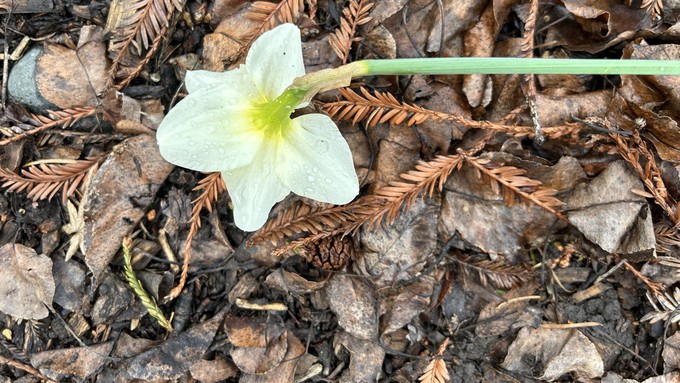
High temperatures take a 20-degree dip from last weekend's warmth

This poor daffodil, wet and face down in muddy mulch, may well epitomize the weather situation for Sacramento gardeners. Kathy Morrison
March came roaring in like a wet, cold lion. Will it leave like a lamb?
As we turn the calendar, Northern California is in the midst of another good soaking – this one much colder than the almost-tropical atmospheric rivers that hit last week. This current storm – dubbed a “blizzard maker” by meteorologists – will drop snow as low at 1,500-foot elevation in the Sierra foothills. Meanwhile, it will be very damp and chilly down here in the greater Sacramento area.
The temperature difference is enough to cause daffodil whiplash. Last weekend, our gardens basked in record-high 70-degree sun. This weekend, we’ll be lucky to see the low 50s. Saturday’s expected high in Sacramento is only 51 degrees with a low of 43.
In other words, our early spring is on hold.
As for rain, February proved to be very soggy. According to the National Weather Service, downtown Sacramento totaled 4.63 inches of rain; that’s 41% more than average for the month.
March tends to be on the wet side, too. And March 2023 was practically a deluge. That month totaled more than 5 inches of rain in Sacramento. Our normal rain total for the month: 2.68 inches.
This March, these first few days will get us off to a very wet start; rain is in Sacramento’s forecast every day through Wednesday.
Temperatures definitely will feel on the cool side, with days about 10 degrees below normal. March averages highs of 65 degrees and lows of 44. (Fortunately, overnight lows will just be in the 40s instead of dipping into the 30s.)
But those cold, damp days will keep our soil cold and damp, too. Until soil warms significantly, forget about transplanting outdoors any warm-season veggies.
While this cold, wet weather may have put a damper on outdoor gardening, make the most of indoor time. In the cozy (dry) comfort of your kitchen, start some seeds of summer favorites.
Aim to move those baby tomatoes, peppers and squash outdoors when the soil temperature finally warms significantly. Judging by current weather models, that will be sometime in late April or early May.
For the latest on Sacramento weather: https://www.weather.gov/sto/#
Comments
0 comments have been posted.Sacramento Digs Gardening to your inbox.
Sites We Like
Garden Checklist for week of Nov. 3
November still offers good weather for fall planting:
* If you haven't already, it's time to clean up the remains of summer. Pull faded annuals and vegetables. Prune dead or broken branches from trees.
* Now is the best time to plant most trees and shrubs. This gives them plenty of time for root development before spring growth. They also benefit from fall and winter rains.
* Set out cool-weather annuals such as pansies and snapdragons.
* Lettuce, cabbage and broccoli also can be planted now.
* Plant garlic and onions.
* Keep planting bulbs to spread out your spring bloom. Some possible suggestions: daffodils, crocuses, hyacinths, tulips, anemones and scillas.
* This is also a good time to seed wildflowers and plant such spring bloomers as sweet pea, sweet alyssum and bachelor buttons.
* Rake and compost leaves, but dispose of any diseased plant material. For example, if peach and nectarine trees showed signs of leaf curl this year, clean up under trees and dispose of those leaves instead of composting.
* Save dry stalks and seedpods from poppies and coneflowers for fall bouquets and holiday decorating.
* For holiday blooms indoors, plant paperwhite narcissus bulbs now. Fill a shallow bowl or dish with 2 inches of rocks or pebbles. Place bulbs in the dish with the root end nestled in the rocks. Add water until it just touches the bottom of the bulbs. Place the dish in a sunny window. Add water as needed.
* Give your azaleas, gardenias and camellias a boost with chelated iron.
* For larger blooms, pinch off some camellia buds.
* Prune non-flowering trees and shrubs while dormant.
* To help prevent leaf curl, apply a copper fungicide spray to peach and nectarine trees after they lose their leaves this month. Leaf curl, which shows up in the spring, is caused by a fungus that winters as spores on the limbs and around the tree in fallen leaves. Sprays are most effective now.